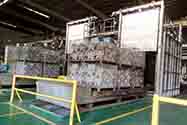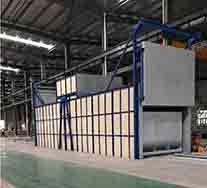In the metal materials processing industry, the aging furnace serves as a cornerstone. By conducting aging treatment, it refines the performance of metal materials, laying a solid foundation for manufacturing top - tier products.
Functions of the Aging Furnace
The aging furnace heats metal materials at a set temperature and holds them for a specific duration. This induces microstructural changes in the alloy, thereby enhancing mechanical properties such as hardness, strength, and wear resistance. For instance, aluminum alloy’s strength can be substantially increased after aging treatment.
For precision parts, dimensional stability is non - negotiable. Aging treatment mitigates material deformation during subsequent use, ensuring workpiece dimensions remain consistent.
For materials requiring further processing, proper aging treatment can improve machinability during cutting. It streamlines the processing and ensures high - quality surfaces post - processing.
Internal stress generated during manufacturing can impact material lifespan and performance. The aging furnace releases this stress by precisely controlling heating and cooling rates, reducing the risk of cracking or deformation.
Since different alloy materials and application scenarios have varying aging treatment requirements, the aging furnace can accurately adjust temperature and time parameters to achieve optimal results.
The aging furnace operates based on aging treatment, a heat treatment process for metals. Its essence lies in altering the internal microstructure of metal materials through precise temperature control during heating and cooling, thus enhancing material performance.

The metal workpieces are placed in the aging furnace, and the furnace temperature is raised to a specific working temperature. This temperature varies depending on the type and alloy composition of the metal. For example, aluminum alloy aging treatment typically occurs between 100°C and 200°C.
Once the required temperature is reached, the workpiece is held at that temperature for a certain period, ranging from minutes to hours. During this time, atomic diffusion and the formation or growth of precipitation phases occur, enhancing material hardness and strength.
After the holding period, the workpiece enters the cooling stage. The cooling rate can affect final material performance, so it may need to be adjusted according to specific requirements. Some materials can be naturally cooled, while others require forced cooling.
The working temperature range of the aging furnace is determined by the material type and its heat treatment requirements.
Typically, the aging treatment temperature for aluminum alloy ranges from 100°C to 200°C. Different series, such as 2xxx, 6xxx, and 7xxx, require specific temperatures within this range to optimize mechanical properties.
For special alloy steels and other metals, the aging treatment temperature may differ and sometimes be higher, depending on the material composition and desired treatment outcome.

Material Type and Alloy Composition: Each material has unique optimal aging treatment conditions. For example, different aluminum alloy series may require different aging temperatures and times. Manufacturers often provide suggestions for heat treatment parameters.
Experimental and Empirical Data: In specific applications, it may be necessary to determine optimal aging treatment time and temperature through experiments. Small - scale specimen tests are conducted, and parameters are adjusted based on performance evaluation.
Technical Specifications and Standards: Many industries adhere to specific technical specifications or national standards for heat treatment. For example, the aerospace industry has strict standards for aluminum alloy component aging treatment.
Production Efficiency and Cost Considerations: In industrial production, both material performance and time cost need to be considered. Excessive aging treatment time increases production cycle and cost, so it’s essential to shorten the time while maintaining performance.
Dynamic Adjustment: Sometimes, aging treatment time and temperature need to be adjusted dynamically according to material reactions. Segmented aging can be used to achieve better comprehensive performance.
For many alloys like aluminum alloys, as aging treatment time increases, fine precipitation phases form, improving hardness and strength. However, overly long aging leads to precipitation phase coarsening, reducing the strengthening effect.
Appropriate aging treatment enhances hardness and strength without sacrificing ductility significantly. But over - aging makes the material brittle, reducing ductility and toughness.
Aging treatment stabilizes the material’s crystal structure and reduces deformation. Longer aging treatment generally provides better dimensional stability.
In some cases, proper aging treatment improves corrosion resistance, such as promoting the formation of a protective oxide film in aluminum alloys. However, improper aging may increase local corrosion sensitivity.
Moderate aging treatment makes the material harder yet still processable. Over - aging, on the other hand, makes the material too hard and brittle, hampering further processing.
Proper aging treatment time promotes the formation of fine precipitation phases, improving hardness, strength, and fatigue resistance, thereby extending the service life.
Proper aging treatment maintains ductility and toughness. Over - aging makes the material brittle, shortening its service life.
Correct aging treatment stabilizes the crystal structure, reducing deformation and extending the service life, especially in precision applications.
Appropriate aging treatment improves corrosion resistance, while improper aging accelerates corrosion and shortens the service life.
Optimizing aging treatment time enhances fatigue resistance, enabling the material to withstand repeated loading for a long time.
Over - aging causes precipitation phases to coarsen or aggregate, weakening their hindrance to dislocation movement and reducing hardness and strength.
Over - aging makes the material brittle, significantly reducing ductility and toughness, increasing the risk of failure under impact or tension.
For some alloys like aluminum alloys, over - aging may alter the surface oxide layer, reducing its protective effect and increasing corrosion susceptibility.
Over - aging may change the material’s internal structure, leading to dimensional instability, especially in high - precision applications.
Over - aging accelerates the formation and propagation of microcracks, shortening the material’s fatigue life.
Material Type and Alloy Composition: Different metals and alloys have different aging treatment requirements. For example, various aluminum alloy series and other metals like steel and copper alloys each have their own specifications.
Expected Performance Goals: Goals of aging treatment vary, including enhancing hardness, strength, wear resistance, ductility, toughness, or corrosion resistance. Different goals require different treatment conditions.
Technical Guidelines and Standards: Many industries follow specific technical guidelines or national standards for heat treatment. Referring to relevant manuals or standards can help determine parameters.
Experimental and Empirical Data: For specific applications, experiments are often necessary to optimize aging treatment parameters.
Production Efficiency and Cost Considerations: In industrial production, both material performance and cost need to be balanced to shorten the aging time without sacrificing performance.
Rapid aging treatment, which involves high - temperature heat treatment for a short time, is suitable for alloys that can be strengthened through precipitation hardening.
2xxx series (e.g., 2024) with copper as the main alloying element.
6xxx series (e.g., 6061, 6082) containing magnesium and silicon.
7xxx series (e.g., 7075) with zinc as the main added element, and may contain magnesium and copper.
Some copper - beryllium (Cu - Be) or copper - nickel - silicon (Cu - Ni - Si) alloys can improve strength and hardness through aging treatment.
This steel contains small amounts of elements like cobalt, molybdenum, and titanium. Low - temperature aging treatment forms ultra - fine precipitation phases, increasing strength without sacrificing much toughness.
For example, Ti - 6Al - 4V can enhance mechanical properties through aging treatment.
Alloys like A286 can achieve excellent high - temperature strength and corrosion resistance through appropriate aging treatment.
BAI KA Copyright © 2025 ALL rights reserved